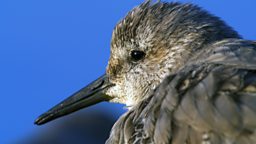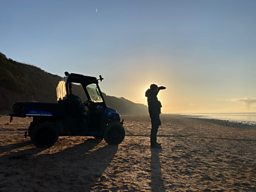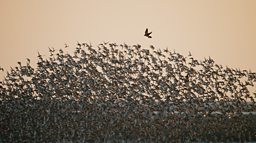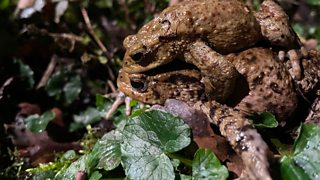One falcon and a lot of knot - securing the shot at Dee Estuary
By Joe Fenton, Assistant Producer
Filming this sequence took patience, local knowledge and lots of thermal underwear!
It started with a trip to the River Dee Estuary by wildlife cameraman Simon King. His extensive knowledge of British wildlife meant he knew this patch had the potential to capture a dramatic behaviour like never before.
Our shallow seas and high tidal range create rich mud flats packed full of crustaceans and shellfish - high energy food for hungry winter wading migrants.

Each bird has a specific feeding technique. The long-billed curlew digging deep, the tiny robin-sized turnstones delicately searching every nook and cranny and then the knot - one of the species we had come to film.
Feeding wise they are kind of an all rounder, with medium sized flexible beaks, but they stand out from the others by always feeding in a crowd with other knot. En masse they hoover up small marine snails, quietly calling to each other within the group, warning each other of danger in the distance.
A possible impending peregrine, the antagonist for this sequence.
The knot are winter visitors to our shores with most heading south from the arctic to our relatively warmer shores. Drawn here by the richness of the intertidal zones at river mouths with two of the most popular areas being the Wash in Norfolk and the Dee estuary near Liverpool.
we needed to be ready for long cold days standing and watching the knot
Whilst we filmed at both locations, Simon and I were stationed on the Dee Estuary to film the fast paced hunting behaviour. This meant we needed to be ready for long cold days standing and watching the knot.
They weren’t always in the right spot as the flocks would often get disturbed from their feeding patterns by dog walkers or other predatory birds, but there was always plenty for us to watch. I don’t live by the coast so it was a bit of a revelation to see so many birds in the depth of winter.


All the waders are tuned into the tides - they can only feed when the tide is out and the mudflats are exposed – resting when the tide is in. So we had to do the same, sychronising our filming periods with the low tides. This meant some early starts to arrive at the location at the right time.
From a distance the birds were pretty indistinct, blending into the grey mud
When the low tide was early, this meant getting up way before dawn, loading all the kit, driving to the coast, then reloading the kit onto an electric 4x4 that we would use to drive along the beach to get as close as possible to the flocks. The electric vehicle was ideal, quiet and had no impact on the beach, meaning we caused minimal disturbance.
Once we had found the flock we set up the cameras as quietly as possible. On the very early mornings, the flock were usually roosting, packed in tightly with their heads tucked under the wings. From a distance they were pretty indistinct, blending into the grey mud. There could be thousands of birds all tucked into to just few square meters.

Now it was a waiting game. Like the waders, peregrine move around in winter. Not really a migration, but without a nest or chicks to look after they are free to travel further afield, looking for the best areas for prey. In winter, this is often the coasts with the influx of wading migrants.
as they take off as one, the noise of their wings is like a breaking wave in the air
Sometimes the peregrine would arrive with a bang! Straight into the flock. Other times we would get some warning signs of their approach. Like woodland birds an alarm call from any species can be understood by all. It’s the same on the mudflats, if a peregrine is spotted, everyone knows about it!
If the knot are roosting and the alarm is sounded their heads all pop up as one, and they begin to chatter. In the distance we would often see the result of an approaching peregrine as birds take flight. And when a flock of knot do this, it's a real spectacle for the eyes and the ears. Their main form of defense is to put another bird between them and the hunter.
This simple rule results in the flock acting in near perfect unison, as each responds instantly to the birds immediately next to them. As they take off as one, the noise of their wings is like a breaking wave in the air as they twist and turn, the flock shimmers as their white underside flash in ripples. The technique works - several of the hunts we saw ended not by the peregrine catching a bird in the air, but from birds that had been pushed down, hitting the mud.
Most mornings we were joined by two bird spotters who were looking for individual birds within the flock - ones with leg rings. These reveal exactly where the bird carrying them came from.
A bird spotter pointed out a bird that had flown from the Canadian Arctic 15,000 km away
Before satellite tagging, early researchers would attach unique rings to birds legs, which when read or recovered by someone, would reveal how far they had flown. Even today this technique is still being used, especially with smaller birds, who aren’t able to carry the weight of a satellite tag, and with the size of knot every gram counts as they are pushed to the very limit of their capabilities. The weight of a satellite tag would be a death sentence.
Talking to the bird spotter they pointed out an individual with a ring, which revealed it had flown from the Canadian Arctic 15,000 km away.
Looking at the bird tucking into the juicy mud grubs - I found a new level or respect for them.For me it was an awe inspiring sight following months of preparation. For the knot - just another day trying to get enough food to see them through the winter months here in the British Isles, while trying not to become a meal themselves.




